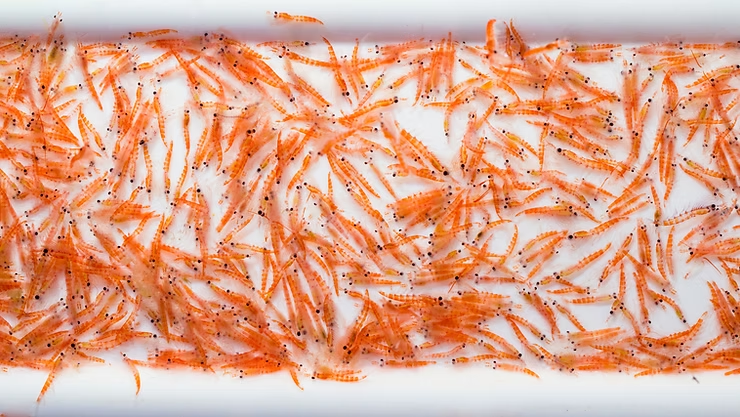Antarctic Krill: Tiny Crustaceans, Giant Impact
Antarctic krill (Euphausia superba) are small, shrimp-like creatures inhabiting the Southern Ocean, playing a vital role in the Antarctic ecosystem and global carbon cycle.
Key Takeaways
- Small, shrimp-like crustaceans found in the Southern Ocean.
- Crucial food source for whales, seals, penguins, and birds.
- Help sequester carbon dioxide, contributing to the global carbon cycle.
- Threatened by climate change, overfishing, and pollution.
- Human activities, including fishing and research, impact krill populations.
Size and Appearance
- Measure about 2–6 cm in length, with a translucent, reddish body.
- Large black eyes, streamlined shape, and swimming legs for mobility.
- Hinged carapace allows curling into a protective ball.
- Can form massive swarms, sometimes visible from space.
- Contain astaxanthin pigment giving their reddish coloration.
Habitat
- Inhabit frigid Southern Ocean waters and Antarctic islands.
- Adapted to cold with antifreeze proteins in their blood.
- Form large swarms, providing a reliable food source for predators.
- Filter feeders, consuming phytoplankton and detritus.
Diet
- Mainly feed on phytoplankton, consuming up to 12% of Southern Ocean primary production.
- Consume detritus, recycling nutrients in the ecosystem.
- Vital link in the Antarctic food chain, transferring energy to predators.
Life Cycle
- Hatch from eggs and progress through multiple larval stages.
- Undergo molting to grow larger and develop new exoskeletons.
- Join adult swarms, reproduce, and continue the species’ survival.
Importance in the Antarctic Ecosystem
- Key species in the food chain, supporting penguins, seals, whales, and Antarctic petrels.
- Regulate phytoplankton populations and sustain predator populations.
- Decline in krill affects the entire ecosystem and predator survival.
Contribution to the Global Carbon Cycle
- Consume phytoplankton, storing carbon in their bodies.
- When krill die or are eaten, carbon sinks to the ocean floor.
- Fecal pellets also contribute to carbon sequestration in deep oceans.
Threats to Antarctic Krill
- Climate Change: Rising sea temperatures reduce habitat and food availability.
- Overfishing: Excessive krill harvests deplete populations, affecting predators.
- Pollution: Plastics, oil spills, and chemical pollutants threaten survival.
Human Activities
- Krill Fishing Industry: Harvested for krill oil supplements; managed by CCAMLR.
- Krill Oil Supplements: Rich in omega-3 fatty acids, bioavailable for human health benefits.
- Scientific Research: Monitors krill populations, behavior, and ecosystem impacts to guide sustainable management.
Interesting Facts
- Swarming Behavior: Krill form massive swarms spanning kilometers, providing protection and feeding efficiency.
- Visible from Space: Swarms can be detected by satellites due to their size and density.
- Bioluminescence: Produce blue-green light via photophores, helping confuse predators or attract mates.
- Omega-3 Source: Krill are harvested for dietary supplements benefiting heart, brain, and joint health.
Conclusion
Antarctic krill are tiny yet mighty, sustaining the Southern Ocean ecosystem, supporting predators, and aiding global carbon regulation. Protecting krill ensures the resilience and balance of one of Earth’s most unique environments.
Frequently Asked Questions
- What are Antarctic krill? Small shrimp-like crustaceans, vital for the Antarctic food chain.
- Why are they important? Serve as food for predators and contribute to carbon sequestration.
- Threats? Climate change, overfishing, and pollution.
- Human interactions? Harvested for krill oil; studied for ecological research.
- Interesting facts? Swarm visible from space, bioluminescent, vital omega-3 source.
- Size and appearance? 2–6 cm long, reddish, translucent, with swimming legs and large eyes.
- Habitat? Southern Ocean, forming large swarms in cold, nutrient-rich waters.
- Diet? Phytoplankton, zooplankton, and detritus.

